What is the best Irish tin whistle (penny whistle) to buy? Or, is there the best Irish whistle brand? Well, there’s no silver-bullet answer to that question. As Colin Goldie (one of the highly experienced whistle makers) says: “There is no perfect whistle for everyone as we all have our own idea of what is good”. Luckily, this guide will help you make the right decision, depending on your taste and needs. And not only in terms of what to buy but also what to avoid buying in specific cases.
Whether you are just getting started and looking for the best tin whistle to buy online for beginners, a loud one for sessions, or one from a professional range, this guide will get you covered. Read further to learn about all characteristics with the pros and cons alongside general recommendations and advice for each one listed here.
Tin whistles for beginners
If you are a beginner and looking for your first tin whistle, you probably want one just to learn the basics and start getting used to the instrument. You want to make sure they are easy to blow but preferably good enough not to provide the squeaks. They are usually inexpensive, with a price range of around $10-$20. One of the most important things to keep in mind is that you definitely want a tin whistle in the key of D. It is considered the standard key, and luckily, all of the whistle makers and brands offer so-called high D (soprano) whistles.
| Best soft tone | Best clear sound | Best non D |
|---|---|---|
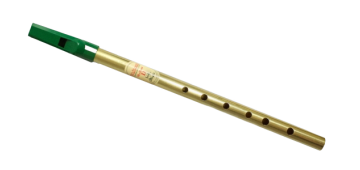 |
 |
 |
| Waltons Mellow D | Dixon Trad D | Generation Brass Bb |
| Amazon | Amazon | Amazon |
Waltons Mellow D highly flexible beginner tin whistle
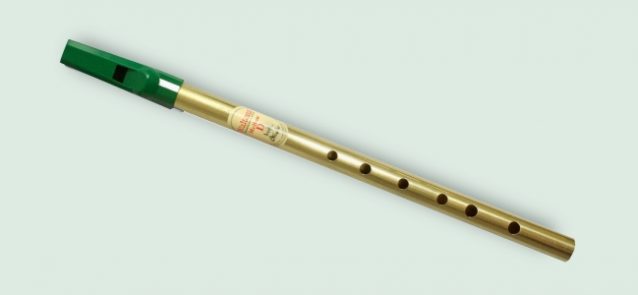
Waltons brand offers several fine models of Irish whistles for beginners, yet advanced players love it too. There are standard and “mellow” models. And the latter appeared to be more recommended by many players. Waltons Irish tin whistle is made of a brass tube with a plastic mouthpiece. As the name suggests, it has a mellow and soft sound. It is also slightly louder among other beginner choices, which is achieved by a slightly wider bore diameter than a standard one.
Besides brass whistles, Waltons also has coated models made of aluminum. Probably the most known is a black one with a Guinness logo. Or without it, called “A Little Black”. And to be honest, it’s probably better to buy this whistle for a gift as it just doesn’t play nearly as well as brass models in terms of tone clearness and stability.
- Mellow but clear sound (similar to some much more expensive whistles)
- Versatile with breath control (can nicely play vibrato and pitch variations)
- Slightly louder (than most of the entry-level whistles)
- It can tarnish over time and reveal stains (as all brass whistles do)
- C & D keys are available
Feadog Brass D tin whistle with very low air requirements

Original Irish whistle, very similar to Waltons (brass tube and green plastic mouthpiece), except it has a bit crispier sound. So, if you prefer a “sweet and tiny” traditional tone, then it is a go-to whistle for you. One more thing to mention is that it is very sensitive. It barely requires any air pressure to be played, but this also means that you can easily overblow the notes.
Overview:- Crispy traditional sound (also a bit tiny)
- Somewhat quiet
- Can oxidize over time
- C & D whistle key available
Feadog PRO D well-balanced beginner tin whistle
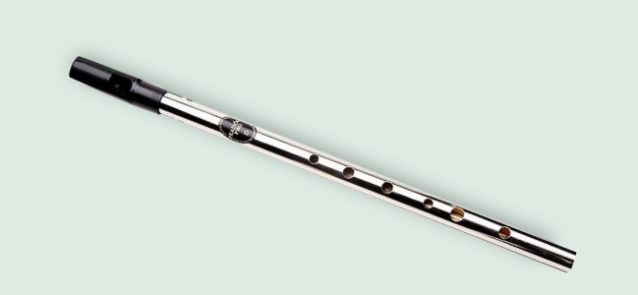
Another decent whistle by Feadog is its latest PRO model, made of nickel. Compared to the brass model, it has a bit richer and softer tone, similar to Waltons Mellow D. Still very traditional sounding and is slightly better balanced (which is why PRO stands in its name) and not so easy to overblow.
Overview:- Nickel body
- Well-balanced between octaves
- Soft & rich tone
- Only key of D available
- Available in silver and black coated color
Clarke original D good airy-sounding tin whistle
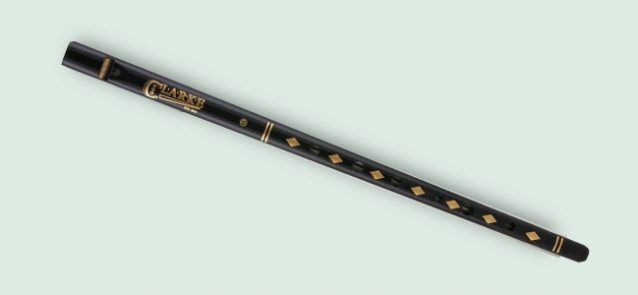
A whistle with a very long tradition, made in England since 1843. It’s definitely a unique whistle among other beginner choices, both by the sound and the look. It has a conical (tapered) bore made of tin, with a wooden plug instead of a mouthpiece. This wood piece makes it arguably the most breathy & husky whistle, which some people may love and some don’t.
Clarke also offers its Celtic tin whistle model, which is made of a tin tube and regular plastic mouthpiece and is much more similar to other beginner choices.
Overview:- Very breathy sound
- Requires more air than other beginner whistles (but is a bit quieter)
- Good volume balance between octaves
- Non-tunable (can be a real issue if you are likely to play with other musicians)
- C & D keys are available
Generation brass Bb high-quality non-D tin whistle
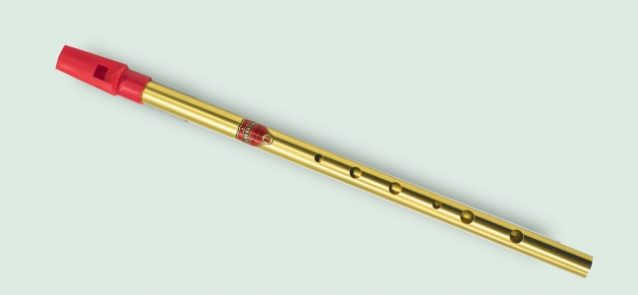
While Generation whistles generally sound very similar to Waltons and Feadog, We’ve heard the same complaint from many players. While it’s a nice-sounding whistle, not every piece of Generation whistles sounds the same, sometimes neither similar. One can be really good, the other may sound squeaky. So, we recommend avoiding Generation D whistle as a beginner, unless you can go to the shop in person and try 10 pieces. Then you may find the one you genuinely like.
However, the major advantage of Generations is that they come in various keys. That’s a scarce case among entry-level whistles. Therefore, it makes them a go-to solution for any other key than C & D. Brass Bb model is especially good, and many players praise Generation brand if you need that specific key. Generation whistles are offered in brass vs nickel models. The nickel ones, except the silver look, sound edgier and brighter, while the brass models have a softer tone. However, they are both very similar, traditional-sounding.
Overview:- Comes in various keys (Bb, C, D, Eb, F & G)
- Generation Bb brass model sounds close to much more expensive whistles
- They differ from piece to piece (and some may sound squeaky)
Dixon Trad D clear-sounding tin whistle
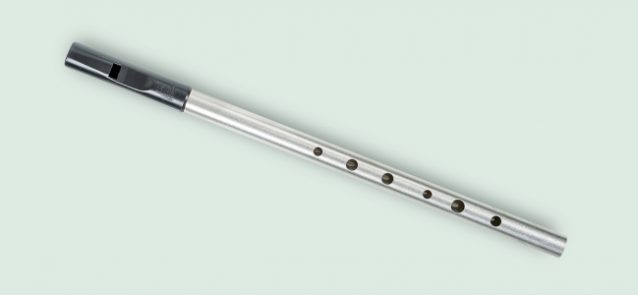
The traditional D whistle made by Tony Dixon has a slightly higher price compared to other beginner whistles listed here, but it is probably well worth it. Dixon whistles are hand-finished, which means that each one you get is tested and of good quality. Thus, you cannot make a mistake by choosing it. Trad D whistle comes in nickel (actually an alloy of nickel and copper), and it has a very bright and sweet traditional tone.
Overview:- Hand-finished whistles
- Easy to play (doesn’t require a lot of air)
- Clear and bright sound on both octaves
- Arguably the sweetest-sounding beginner whistle
- Only the key of D is currently available (other keys were discontinued)
Dixon DX001 entry-level plastic whistle

Another entry-level option by Tony Dixon is the DX001 model. It is a nice plastic tin whistle, clear-sounding, very easy to blow and well-balanced in volume between octaves. It’s not too loud and is perfect for practicing at home.
An excellent choice for beginners who are not intended to play with others, as the only disadvantage of this whistle is not being tuneable.
Overview:- Easy to play (doesn’t require a lot of air)
- Well-balanced in volume between octaves
- Non-tuneable
- Only key of D available
Intermediate tin whistles
Since there has always been a gap between entry-level and professional whistles, various makers decided to produce and offer a range of good-quality whistle models that will fit everyone’s budget. These mid-range whistles are definitely more reliable than beginner whistles, yet much closer in quality to the ones in the professional category.
To avoid any misunderstanding, this doesn’t mean these whistles aren’t recommended for beginners. On the contrary, if you’re a beginner willing to spend a bit more, these whistles are likely easier to play and more reliable.
| Bright and sweet | Versatile | Trad |
|---|---|---|
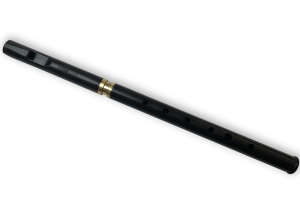 |
 |
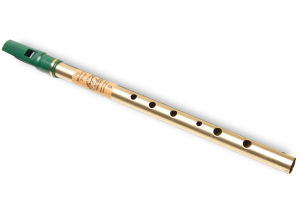 |
| Dixon DX005 | Lir | Mellow Dog |
| Amazon | Lir Website | Amazon |
Dixon DX005 best plastic tin whistle
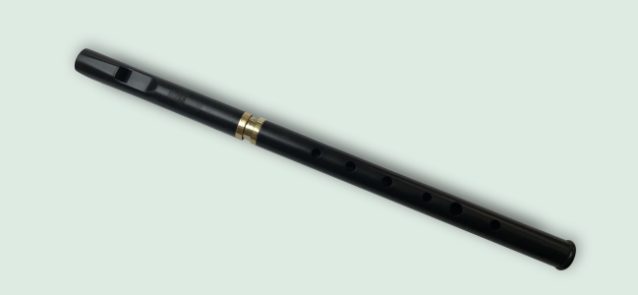
Another Dixon option is a DX005 model. It is basically a tunable and slightly improved version of DX001. And it’s liked by both beginners and experienced players. The addition to the plastic body is the handmade brass tuning slide, which is excellent for smooth tuning. It has a clear and sweet tone, except for the plastic that usually lacks a bit of the traditional sound, which some players love, and some don’t.
Overview:- Hand-finished instrument
- Very easy to play (doesn’t require a lot of air)
- Clear sound, well balanced in volume between octaves
- Only key of D available
Killarney

Made in Ireland, the Killarney whistle has a very bright and clear tone with excellent responsiveness to ornamentation. By its look, it’s almost identical to legendary John Sindt’s whistle. It’s also similar sounding. Killarney makers Padraig and Tadhg Buckley smartly entered the market to fit the needs of many players who weren’t willing to be on Sindt’s colossal waiting list.
In general, Killarney is a narrow-bore whistle, slightly on the quiet side, and is a great choice for players that like easy-blowing whistles. It requires very little air in both octaves. But, on the other hand, it may become an obstacle to those who prefer more dynamics and a bit of a push in their playing.
Besides the most popular brass model, Killarney also offers a nickel-plated version that barely has any difference in the sound. It’s more of an aesthetic choice.
Overview:- Soft blower
- Very responsive
- Crisp and clear tone
- Available in the keys of D, C, Eb and Bb
Lir

A modern take on the Irish tradition, as their maker says. The Lir tends to be a traditional-sounding whistle with a shiny look. It’s basically made from brass but finished off with a silver-plating. The head is made from Delrin.
It has a slightly wider bore than the Killarney, it’s still very pure but a bit softer sounding, with less chiff. Also, this whistle is very versatile, which means you can play it with little to no air, but you can also lean into the notes for more dynamic playing. It will accept it and won’t break the sound.
Overview:- Silver-plated
- Versatile (easy-blower but can be played with more dynamics)
- Clear and soft sound
- Available in the keys of D, C, Eb, Bb and A
Wild McNeela solid-coated brass whistle
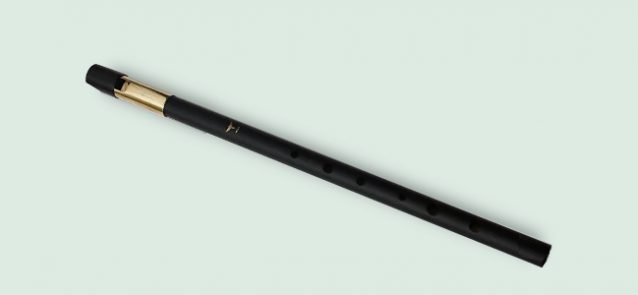
Another recent make, the Wild Irish whistle, is produced by the famous McNeela Instruments. It’s a regular brass whistle with a Delrin head, but it’s also solid black-coated for a more refined look. It has become very popular since its launch in 2020.
Wild whistle has a clear and mellow traditional sound and easily fits almost any player’s needs. The only disadvantage to some players may be the whistle’s weight. It’s a thick-walled brass whistle, making it slightly heavier than an average penny whistle.
Overview:- Black-coated brass whistle
- Mellow and clear sound
- Slightly heavier than average
- Available in the keys of D, C, Eb, Bb and A
Mellow Dog tweaked traditional tin whistle
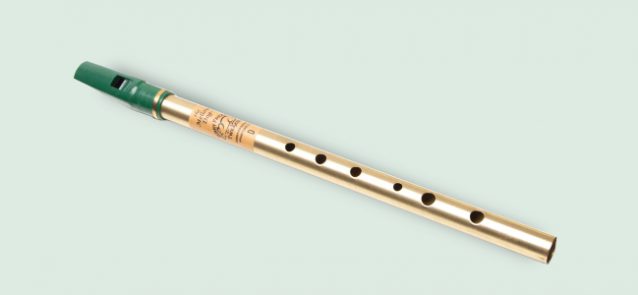
Jerry Freeman became famous by specializing in tweaking and improving cheap entry-level whistles over the past few decades. And the Mellow Dog is probably his flagship model (besides a few others such as Blackbird, Bluebird, Tweaked Generation…). It is basically a hybrid of a brass tube used on Waltons Mellow whistle with the mouthpiece of a FeaDOG whistle, hence the name.
If you love the traditional sound of an original Irish penny whistle with just the right amount of softness and chiff, this is a whistle for you. It’s like an entry-level whistle voiced to be a professional instrument. Tuneable, balanced, and easier to play without having squeaky notes in the upper octave.
Overview:- Tweaked tin whistle
- Traditional sounding
- Mellow tone with just a bit of chiff
- Available in the keys of C and D
Dixon DX006

Another good model by Tony Dixon, DX006 is made of an aluminum body with an ABS plastic mouthpiece and has a wider bore that naturally provides more sound volume. Definitely the loudest Dixon model at the moment. It has a rich and soft tone and is tunable, making it well-suited for recording and playing with other traditional instruments.
Overview:- The rich and mellow sound
- The loudest Dixon model
- C and D keys are available
Shush PRO the quietest tin whistle

Crafted in Sheffield, UK, this whistle is designed with a singular goal in mind – to be the quietest tin whistle available. It’s an upgraded, tweaked version of the Feadog, made from brass and features a sleek black color coating. While notably quieter than typical models, it is also very air-efficient and produces a balanced and controlled sound, setting it apart from most entry-level whistles. A definite step up, highly recommended for home practice, allowing you to enjoy your music without disturbing your family or neighbors.
Shush Instruments also provides a budget-friendly option called the Shush Classic, offered in natural brass or nickel finishes rather than the black coating.
Overview:- Quieter tin whistle, ideal for practicing
- Great playability and balance between octaves
- Soft sound with just a bit of “chiff”
- Tuneable
- Available in the key of D
Loud tin whistles for sessions and stage performance
When it comes to choosing a tin whistle (penny whistle) for playing with other people, loudness plays a much more important role than sound. You want to make sure your whistle can cut through the wall of noise made by guitars, fiddles, bodhrans, you name it. Also, if you play live on a (small) stage, you want to avoid that nasty microphone feedback, which almost always happens if a whistle is not loud enough.
While most of the professional high-end whistles are decently loud and will serve the purpose too, here are several examples of mid-range priced whistles that can get you the loudness for a price range of around 50$ to 150$.
| The loudest | Best trad sound | Affordable |
|---|---|---|
 |
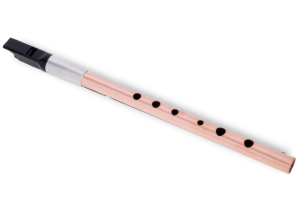 |
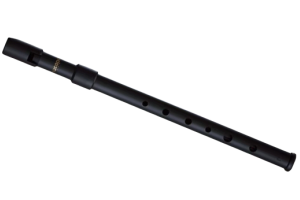 |
| Susato Kildare | Optima Cobre | Woodi USA |
| Amazon | Amazon | Amazon |
Susato tin whistle with plenty of volume
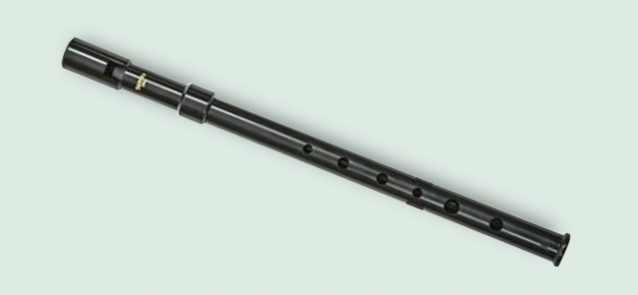
Susato whistles are made of ABS plastic and have a clear and crisp sound in both octaves. The upper octave is a bit shrill, maybe even too much if you practice at home. Plastic whistles, in general, have a sweet tone, but they kind of lack traditional smoothness and may sound slightly artificial. However, they are fairly popular among some of the best tin whistle players.
Susato offers several models with a full range of keys from lowest to highest. Their most popular model is “Kildare,” and they also introduced a similar model named “Oriole”, an economy version of Kildare. The great thing with Susato is that they offer combo options with a single head (mouthpiece) but with multiple tubes in different keys. This means you get several whistles as a “3 in 1” set, and at a very reasonable price.
It’s also worth mentioning that Susato high whistles come in S (small bore) and V (very small bore) models. The V version is a bit quieter and not too shrill in the upper octave. However, both modes will get you the desired loudness.
Overview:- Very loud in both octaves
- Clear sound
- Tunable
- Durable ABS plastic yet really light
- Available in many keys (Low C to High F)
- Offers combo set with one head and multiple bodies
Woodi affordable tin whistle C & D set

Not only does it look like a Susato copy, people who’ve been playing it say the sound is very similar too. It seems that the only “issue” with these whistles is that Woodi USA is still not a well-known and established brand on the market.
Probably the best thing with “unknown” brands is that the price usually needs to be low, despite the quality. Thus, Woodi USA whistles are definitely worth checking out. At least if you still don’t have a loud whistle to pull out in sessions occasionally. At the moment, they are only available as a set of two and in the most common keys of C & D.
Overview:- Loud in both octaves
- Clear and rich tone
- Tunable
- Durable ABS plastic
- Only available as a set of two (C & D keys)
Busker (ex Chieftain) great volume and rich sounding tin whistle
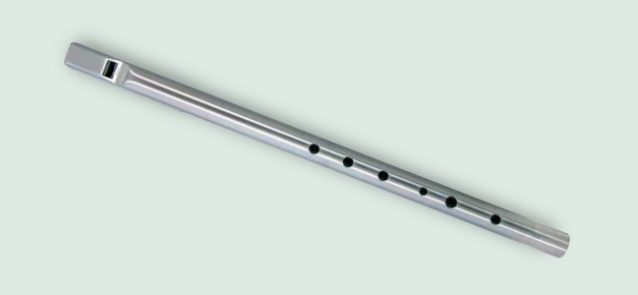
Made by Phil Hardy, known as the maker behind the Kerry whistles brand (for low whistles). The Busker high D whistle seems to be the successor of the well-known Chieftain thunderbird whistle (which can still be found in lower keys). They are handcrafted whistles made of aluminum and have a rich sound and mellow tone. And as the name says itself, they are loud too! It seems that the only “issue” with them is they need slightly more air in the upper octave, but some players prefer that, actually.
Overview:- Rich and mellow flute-like sound
- Tuneable
- Great volume but requires more air pressure in the upper octave
Optima Cobre copper tin whistle

Another good and recent model by Phil Hardy is the Optima Cobre. This is an interesting whistle with a copper body, an aluminum tuning slide and a plastic head. Compared to the Busker, it has a less soft and more direct sound, responsive to ornaments.
It’s an easy blower but can also accept more breath pressure for dynamic playing. It has a wider body, requiring more push in the upper octave. Pure sounding, with just a little bit of chiff. Aesthetically, as the copper tarnishes very quickly, you can expect that the shiny rose-gold color becomes dark brown(ish) in just a few weeks of playing.
- Copper body with aluminum tuning slide
- Punchy, direct sound
- Available in the keys of D, C and Eb
Milligan loud delrin/wooden tin whistle

Milligan whistles could easily fall into the professional section in this article as they are for sure high-quality hand-made whistles. However, we decided to place it right here in the “loud” section because they are definitely one of the loudest brands. Gene Milligan is an experienced maker, creating whistles for many years with a very interesting construction concept. The Milligan whistle’s head is made of delrin polymer, while the body (tube) is made of wood, and there are several wooden materials to choose from. And as Gene stated, various kinds of wood only slightly differ in sound characteristics. It’s more of an aesthetic choice and what the player considers more appealing.
Milligan’s whistle also has a brass tuning slide that will get it in perfect pitch. These whistles have it all, the loudness, the rich and clear sound, traditional smoothness, and great response to ornamentation. The only “issue” might be that it does require more air than an average whistle. It’s worth noting that the maker also offers an alternative head type that makes the whistle quieter and is perfect for practicing at home.
- Composite models, made of delrin head with wooden body
- Clear sound and full rounded tone
- Requires a bit more air in the upper octave
- Session (loud) and quiet whistle heads, two types to choose from (or have both with a single body)
- Various keys available (A, Bb, C, D, Eb)
Professional tin whistles
Not only do they sound amazing, but their playing capability is also almost limitless. Advanced players love high-quality whistles mostly because they can express those nuances in ornamentation and airflow, which can hardly be achieved with inexpensive whistles. And that’s a significant difference.
All of the professional tin whistles are hand-made and thoroughly tested, and you can be sure you get a well-balanced instrument. Their price goes from around $200 and up, but since they are usually expected to last for a lifetime, they are definitely worth it.
| Best rich tone | Best clear sound | Best wooden |
|---|---|---|
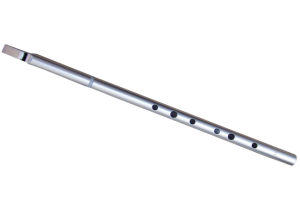 |
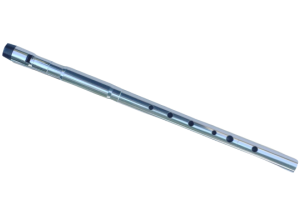 |
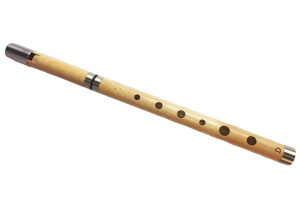 |
| Goldie | Burke | McManus |
| Check availability | Check availability | Check availability |
Goldie (ex Overton) professional rich-sounding tin whistle
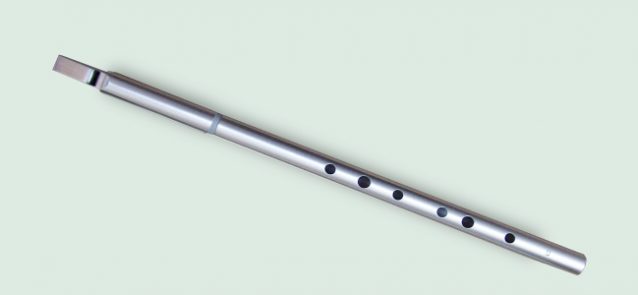
These fine whistles are made by Colin Goldie, who was learning his craftsmanship from legendary Bernard Overton for many years. Overton whistles were originally made as low whistles only, but soon they became available in higher keys. Colin now offers various keys all the way from Bass G to High E, which is an amazing range.
Goldie whistles are made of aluminum and provide both rich and mellow flute-like sound, especially in lower keys. Colin offers three types of whistles: medium, soft and hard blowers. In respect of the breath pressure you want, soft blowers require less air than standard and hard models. Tailored to your personal preference!
Brian Finnegan, who is considered one of the best tin whistle players today, is well-known for playing the Goldie whistles.
- Handmade with a lifetime warranty
- Thick aluminum, strong in its construction
- Soft and very rich sound
- Both tuneable and non-tuneable options
- Comes in all keys (low and high)
- Multiple models by breath pressure (soft, medium and hard)
- A narrow mouthpiece that may clog up frequently
Burke clear-sounding professional tin whistle
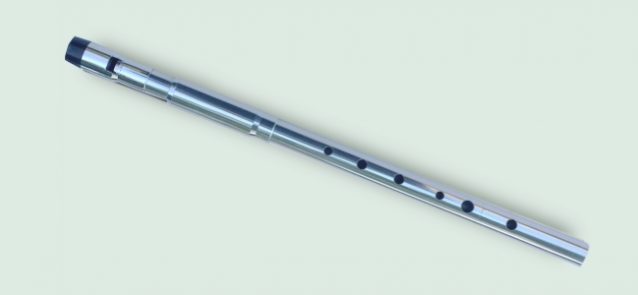
Made by Michael Burke in the USA, these whistles are arguably the purest-sounding ones. They are very focused and responsive, similar to plastic whistles. But opposite to plastic shrillness, they are very balanced and creamy at the second octave.
Burke high whistles come in a few different types. There are “session”, “wide bore” and “narrow” models, which are classified by the sound volume and slight differences in blowing requirements. And to be honest, you can easily avoid a narrow model unless you have a good reason to get a quiet whistle rather than a louder one. Also, Burke offers brass and aluminum models, where brass naturally produces a traditional mellow sound while aluminum sounds a bit edgier and less complex.
While a whole range from low to high whistles is available, most of the players choose Burke for high whistles. Their low whistle models are not significantly (if at all) better than other (usually less expensive) brands.
As an example, you can often see Joanie Madden from Cherish the Ladies playing a Burke.
Overview:- Arguably the purest sounding whistles
- Very responsive to ornamentation
- Handmade
- Tunable
- Brass and aluminum options
- Narrow, session and wide bore options (by loudness)
- Comes in all keys but usually used as high whistles
McManus wooden tin whistle

It is not the whistle material that first comes to mind when one thinks of traditional Irish music, but its distinctive sound and unmatched sleek and elegant look made them many players’ choices. Made by Roy McManus (MacMaghnuis) in Belfast, these whistles are favored by professional musicians who prefer wood. They are loud and clear sounding, with a full, rounded, textured tone in both octaves.
McManus whistles are available in many keys, low and high, and offered in various wood materials, each giving its own specific character to the whistle. From boxwood and hornbeam, all the way to blackwood, cocobolo, or other exotic woods.
Overview:- Loud and full sound, rich & textured tone
- Handmade, tuneable & well balanced
- Various wood materials available
- Comes in many keys, low to high
MK Midgie
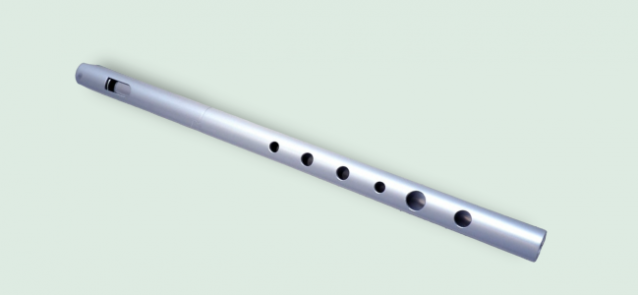
Made by Misha Somerville and his team in Scotland, MK whistles have become popular among low whistle players because they focused on making only alto and low whistles for a long time. In recent years, they came out with their first high whistle model, the Midgie, which kind of like reminds of a Goldie whistle. It’s a wide-bore, aluminum tunable whistle with good volume and a rich tone that you’d expect from a thick-wall aluminum whistle.
One cool feature of the Midgie is its mouthpiece design, which has a curved windway that usually helps prevent condensation and moisture buildup inside the whistle head. Besides regular aluminum finish, it also comes in various colors of anodized aluminum (green, red, black, purple, bronze, blue) that look really sleek.
Overview:- Professional aluminium tuneable whistle
- Rich and rounded sound, easy to play
- Features multiple anodized aluminium colors
- Only the key of D is available (as a high whistle)
- Lower keys from alto A to bass C
Carbony lightweight carbon fiber whistle
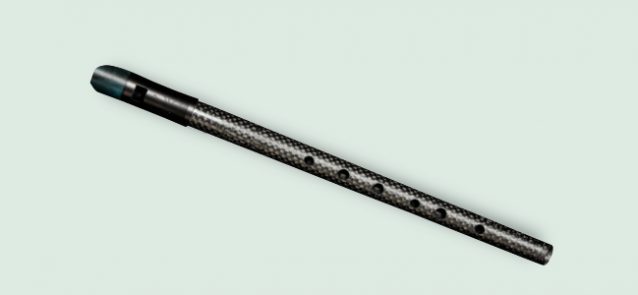
Another interesting concept and unique material among whistles. Carbony whistles, as the name suggests, are made of carbon fiber and are literally indestructible yet very lightweight. They are hand-made by Rob Gandara, the owner of the Carbony Celtic Winds company in the USA, and are offered in many all keys, low to high.
Carbony whistle is designed with a conical bore and has a soft, mellow sound. It is probably the most breathy-sounding whistle among professional whistles. We can easily say they are similar to Clarke’s original, both by the look and the sound. But of course, with great precision in its construction, as a professional instrument should be made. So, if Clarke whistle was your choice as a beginner, then Carbony should probably be a logical step-up.
Overview:- Hand-finished whistles with a lifetime warranty
- Breathy, mellow sound, balanced in both octaves
- Tunable, with perfectly accurate pitch
- Light-weight and durable (made of carbon fiber)
- Various keys available (low and high )
Sindt professional trad tin whistle

Made by John Sindt in the USA, these whistles have a very long tradition, especially among Irish players. Probably because of the way these whistles sound, traditionally beautiful. While they are slightly quieter among professional whistles, advanced players love them because of their clear and direct tone, and great balance between octaves. Sindt Irish whistle is made of brass and produces both crispy and sweet tones similar to cheaper traditional ones (i.e. Feadog or Waltons). Still, they are handcrafted and perfectly balanced, as a professional instrument should be.
It’s a favorite among many traditional Irish musicians and great whistle players, like Mary Bergin, for example.
The only “minor” issue is that they are rare to find, and the waiting list is huge to acquire new ones, as John doesn’t produce them massively. There is no way to order it online through the website but if you are interested, please contact us and we will provide an email to contact and order the whistle from John directly.
Overview:- Made of brass, clear and mellow traditional sound
- Well-balanced between octaves
- Slightly quiet
- Very rare to find (which increases the price)
Tin whistles for children (colored whistles)
To put it this way, kids love colors! They would rather create a bond with the look than the actual sound quality. And that connection will eventually lead towards more passion for playing. While many of our beginner’s choices will serve the purpose too, most popular whistle brands offer their special production line, aimed at children or just anyone who prefers colors more than the original “metal” look.
Don’t be concerned if they play nicely. They surely do and are decent entry-level instruments. Make sure to get an additional piece for your kids when buying a whistle for yourself.
Clarke Sweetone
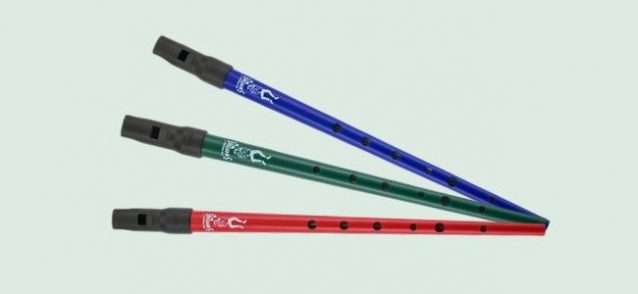
Besides its original model (with a wooden plug), Clarke offers colored models named “Sweetone”. They are made of tin with a black plastic mouthpiece and sure are fun and easy to play. It also follows the original Clarke shape, having the conical bore. Some players prefer the sound of Sweetones as it is not too airy as the original Clarke model. Unlike other similar colored brands that usually come in the key of D only, Sweetone has the key of C available as well.
Overview:- Made of tin, with a plastic mouthpiece
- Sweet sound
- Available in green, blue, red, black, gold and silver colors
- Available in C & D keys
Waltons Rainbow
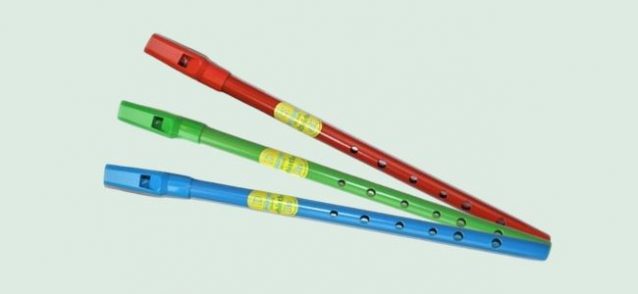
Walton’s model named “Rainbow” is all about light colors. They are made of aluminum, which makes them very lightweight, and with a plastic mouthpiece that matches the body color. They have the sweetness, they have the traditional chiffy sound, and kids love them.
Overview:- Made of aluminum, with a plastic mouthpiece
- Very lightweight, sweet-sounding
- Available in light green, light blue, red, pink, and yellow
- Only the key of D available
Generation Aurora
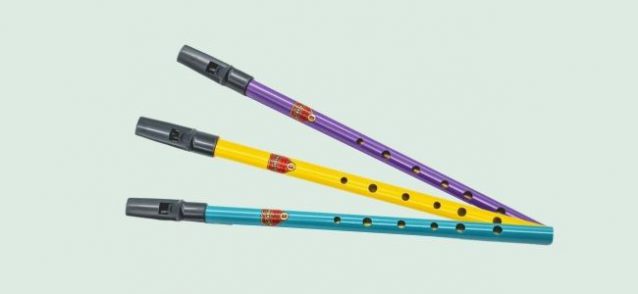
Generation brand also offers colored models with exactly the same sound as the traditional Generation brass. It’s for those who want a splash of fully saturated, metallic lookalike colors, opposite to Walton’s lightness. So, it’s up to your taste!
Overview:- Made of brass, with a black plastic mouthpiece
- The same sound as the traditional Generation brass model
- Available in teal, yellow, and violet colors
- Only the key of D available
Feadog colored
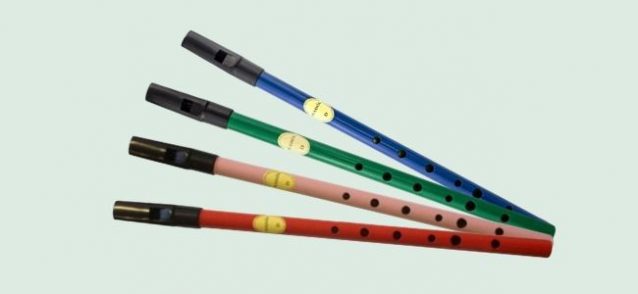
Feadog has its own production line of colored whistles, too. And it is practically the same as the original brass model, except it is color-coated.
Overview:- Made of brass, with a black plastic mouthpiece
- Available in blue, green, red, pink, and black colors
- Only the key of D available
Generation Boho
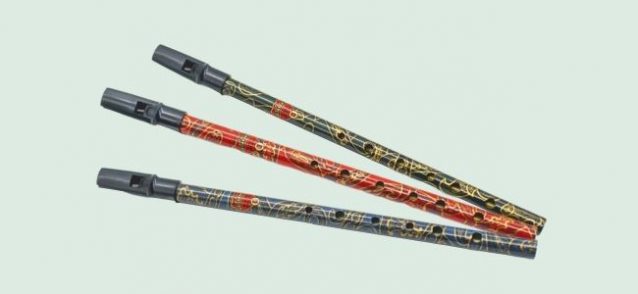
Boho is a rather fresh and specially designed model by Generation and it’s something completely different. As the company stated, the design was inspired by “musicians, artists, poets, beats & freaks, and the revolutionary energy”. We can say it plays nicely, while its elegant look can make it a perfect gift for someone who doesn’t only love whistles, but music & arts in general.
Overview:- Brass tube, with a black plastic mouthpiece
- The same sound as on the traditional Generation brass model
- Available in Gaslight red, Kerouac black, Bohemian blue, and Macdougal green designs
- Only key of D available
General tips for choosing the right tin whistle for yourself
We know that choosing a tin whistle is sometimes limited to your budget and depends on your personal sound preference. And while that is completely fine, it’s entirely subjective. There are several important factors to consider and ask yourself before deciding what tin whistle you should get. Even if you love the specific look, we want to avoid possible pitfalls and ensure you can actually play the whistle and use it as the instrument in the context you need it.
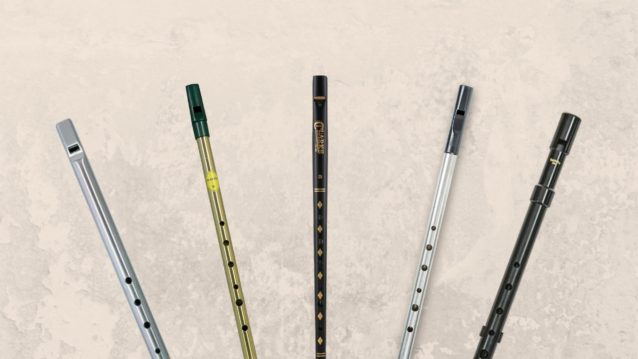
Mass-produced vs hand-finished
Mass-produced whistles are not thoroughly checked and tested and may come with slight variations from one piece to another. And that can sometimes impact playability. While this doesn’t happen too often, it’s always better if you can go to the store in person and try several pieces to decide which one sounds the best. The good thing with mass-produced whistles is they are really affordable. So, if buying online, why not get two pieces and lower the risk? However, 99% of the entry-level whistles will serve the purpose for beginners. And to be honest, these are all lovely instruments with which you can start learning and practicing, just don’t expect you will do wonders with them. Even some brands (i.e. Dixon) hand-finishes their entry-level whistles and the price is only slightly above the average.
On the other hand, professional whistles are all hand-finished or even entirely handcrafted, whereas some makers even offer to tailor the instrument for your specific needs. This, of course, puts them into a significantly higher price range. But, if you need a whistle for recording and some serious music work, buying a mass-produced whistle will not serve the purpose in most cases.
Non-tunable vs tunable whistle
A tunable whistle is handy because you can easily adjust its pitch to be in tune with other instruments or if you play along to any music at home. Luckily, most of the manufacturers provide tuneable whistles. As the rule of thumb, if you need a whistle to play with other musicians, go for a tin whistle that can be tuned. If you only need it for practicing at home, then it really doesn’t matter.
It’s worth mentioning that some high-end makers optionally offer both tunable and non-tunable models (i.e. Goldie). If you can be sure that a specific whistle is from a good maker and in the perfect pitch, you can easily save some money as non-tunable models cost less. And while a non-tunable whistle doesn’t require tuning all the time, it saves the time too, right? Also, some players love the so-called one-piece models as there is less chance for breaking and damage. As you can see, there are definitely some pros when it comes to non-tunable whistles too.
What key tin whistle should you get?
To put it simply, if you are just getting started and are likely to play traditional Irish music, the first whistle key you should get is the key of D. Most of the Irish traditional tunes can be played on a high D whistle, as it covers two of the most common major scales, D and G. Besides that, almost all tin whistle tutorials and books are written with the key of D in mind. Entry-level brands usually offer models only in the keys of C and D, as the two most common. With the exception of the Generation brand, it’s scarce to find affordable whistle in other keys than C and D.
It appears that Eb key is also fairly popular among some players. And some sessions will require you to use this specific key. Therefore, if you need a key that can play different scales on a tin whistle, you must consider more expensive brands and models.
Tin whistle material characteristics
While purists may say that every material has its own character, most of the tin whistle makers praise that the different materials, despite the look, only slightly impact the overall sound of a whistle. Tonal characteristics and playability are mostly accomplished with the specific construction of the mouthpiece. And this is where the magic happens. This can be easily noticed when you hear and compare the sound of different material whistles of the same brand. It is just a slight difference. But, comparing the different brands that use the same material, you’ll hear it. However, there are specific characteristics (not only tonal), and we’ll cover some of them here.
Brass
Brass seems to be a widely used metal, not only for the tin whistle but many other wind instruments as well. Besides good resonance properties, it also has a slightly more textured sound than other metal materials. It will tarnish over a short period of time and reveal stains. Some players prefer to see the finger marks on the whistle body while some others don’t.
Nickel
Nickel whistles are basically brass whistles, usually just “nickel-plated”. They have a shiny silver look and are easier to clean and maintain. However, this glossy finish makes nickel whistles a bit slippery and some people find it harder to play. It sounds just a bit more clean and edgy than the brass.
Aluminum (aluminium)
Whistles made of aluminum alloys tend to have a bit softer sound than brass and nickel ones while keeping the rich and complex tone. It is a very lightweight material, which makes it a popular choice among low whistle makers. One of the major downsides of aluminum is probably because it is the least temperature-resistant material. It can get out of the pitch at extremely high and low temperatures, especially when the mouthpiece is made of aluminum too.
Plastic (ABS, delrin, polymer)
Plastic whistles are flexible and forgiving to design imperfections, which makes them easy to maintain. Yet, they are lightweight and durable. They tend to be sweet and pure-sounding, but their acoustic capabilities may not suit everyone’s taste. Some people consider it “dull” and recorder-alike because they might lack the traditional whistle’s warmth. They can also sound a bit piercing in the upper octave. Most of the makers choose plastic for the mouthpiece as it is very resistant to clogging.
Wood
Wooden whistles definitely have some distinctive texture and complexity in their sound, and most of the players find them very attractive. However, their main disadvantage is maintenance. They are not water-resistant thus sensitive to humidity and need special care. Even a trivial inattention may cause permanent damage to the fragile instrument that is expensive.
Volume and breath requirements
As a beginner, you likely need a whistle that doesn’t require a lot of air. That’s why most entry-level whistles are made as so-called easy-blowers. However, if you have prior experience with other wind instruments, you may find the tin whistle too sensitive and unexpectedly hard to play, where you easily keep overblowing it. The tin whistle requires far less air pressure than some other wind instruments, such as clarinets, saxophones, trumpets, etc. If that’s the case, you would probably be more satisfied with “hard-blowers”, which are less likely to be found within the entry-level price category.
While it might not sound logical, it’s also good to note that easy blowers typically have less back-pressure, which means that although they require less air to produce the sound initially, they tend to “take” more air quickly. This basically means you will need to take a breath more often when playing an easy-blowing whistle.
Regarding volume, we would always recommend a louder whistle as it’s more versatile when it comes to overall dynamics and playability, especially if you play with other musicians or live on stage. But, if there is a good reason for it, such as practicing at home and not disturbing your family or neighbors, quiet whistles may suit you better. Keep in mind that lower keys generally sound softer, so, if you prefer a quiet tin whistle, consider C or Bb keys as they sound less shrill than the D.
Construction characteristics
Before we sum things up, it’s also worth mentioning how some whistle construction features may affect the sound and overall playability. There are a few pros and cons to consider. As a rule of thumb, the wider the bore (tube), the more volume a whistle can provide, but it also means that you need more air to reach the notes in the second octave. Narrow-bore whistles usually provide better balance in air pressure and volume between octaves (that’s why they are usually recommended for beginners).
Additionally, most whistles usually have thin walls, which will produce more “open” sound. On the other hand, thick-walled whistles (ex: Goldie, Busker) produce slightly more complex and richer tone, but also tend to sound more “compressed” and “mellow”. This means they are somewhat easier to control and are less likely to produce squeaks. But, it also means that ornamentation on thick-walled whistles will generally sound less prominent.
Also, you may want to note that a tin whistle with a curved windway (ex: Lir, Killarney, Burke, MK…) is generally less prone to retaining saliva and condensation compared to one with a straight windway, so it can help prevent the frequent buildup of moisture.
Wrapping upAs in most cases with musical instruments, the more money, the more music. But luckily, the entry-level tin whistles are among the most affordable and perfect for an easy start. Besides the whistles listed in this article, there are plenty of other less-known whistle makers who can possibly create fine instruments for a reasonable price. If you are interested in more options, you may want to check Chiff and Fipple forum for the acquisition and exchange of used whistles and also, there is a whistle marketplace Facebook group with the same purpose.
If you have any concerns or need advice, do not hesitate to ask through the contact form below. And feel free to share your experience so far and suggest any whistle that you think should be added to the list.

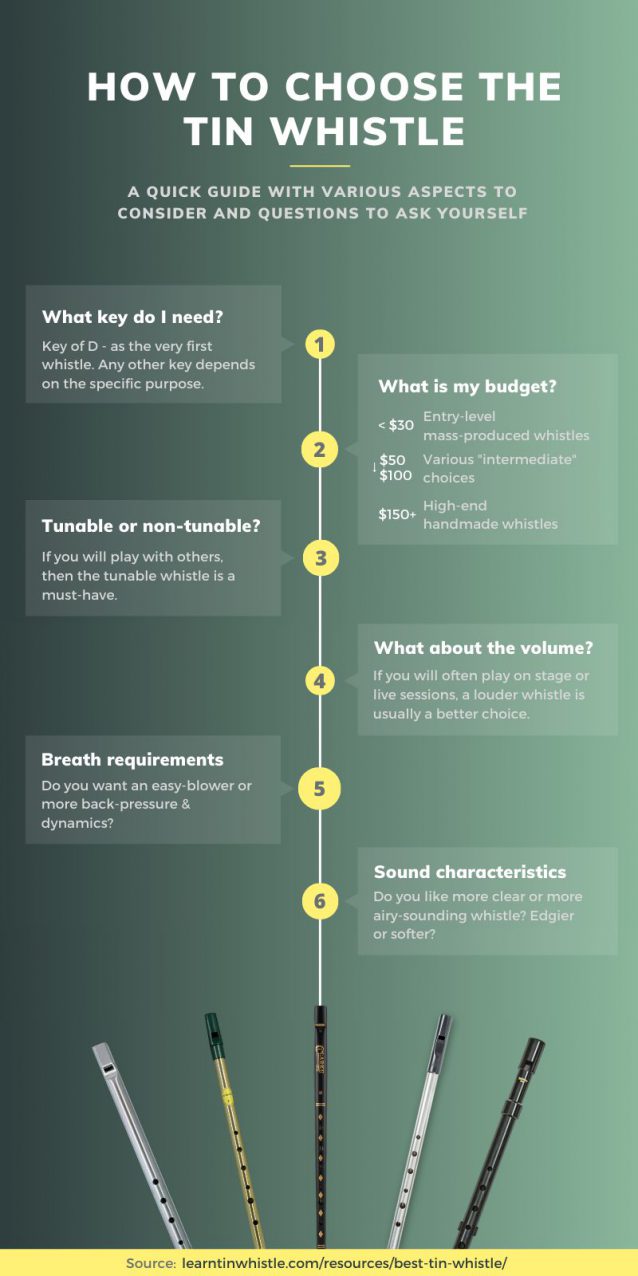

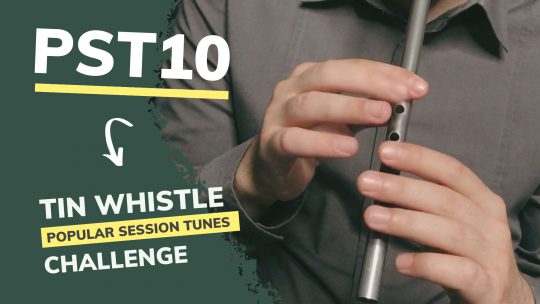
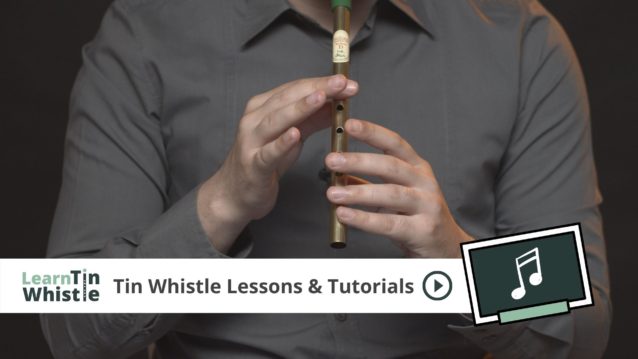
I am not keen on high D whistles, but can’t play Low D (too much stretch). Of course I want to play in D, so am considering getting an alto A whistle and using it to play in key of D. Mostly I play on my own, but hope to play with others at some point.
Hi Alison,
Sure, you can play in D with an A whistle. There are quite a few options for whistles in the key of A, depending on your preference. And these are not likely to be found among entry-level whistles, so you should consider intermediate to profesional range. For example, Lir, Wild, Susato, Burke, Goldie, MK…
I am totally new to tin whistle. I have an old one but find that when I try to blow it, it just sounds whispy or sometimes doesn’t even make a sound when I blow into it. Do I need to blow in a certain way?
I’m happy to buy a more sophisticated whistle but am wondering if the problem is just in the way I blow into it.
Most whistles require very little air to be played, especially in the lower octave. So, considering that you probably already tried to clean it, it is likely a faulty whistle.
I am a beginner. I bought a Dixon DX005 and I returned it because it had too recorder-like sound and second octave is too loud for me.
I want more the traditional sound and not too loud. I bought a Generation Bb and it is really good! But I want a whistle in a higher range of price, well balance, brass if possible, mellow, good for learning. Some whistles are not possible as Mellow Dog not available at Europe.
Considering Dixon DX006, in C or D… Killarney/Lir/wild I think they are too heavy and as I am a beginner, I think they deserve a more experienced player to take the best of them….¿?
So, should go for the DX006 in D or, to look for the mellow tone not too loud better the C key? Will aluminium material fit my requirements? I prefer the brass but don’t know if with the DX006 I will find the ‘good’ whistle to start the journey.
Mellow Dog should be available in Europe, please check if you can order it through Jerry Freeman’s Ebay page.
As for other models, if you like how Generation Bb sounds, you would possibly like Lir/Wild/DX006 more than Killarney. However, all very easy to play, suitable for beginners. And yes, the C key is “softer” than the D.
If I wish to buy a good quality whistle with a mellower and deeper tone which is not squeaky or very high pitched, which one should I go for? I guess I’m willing to spend a bit for the sake of quality.
Aluminum whistles tend to have a deeper tone. So, Goldie or Busker are probably the best choice. Lir, Burke, Wild, Dixon DX006 are also good options. To avoid “squeaky” tone, consider a slightly lower key, like a C or a Bb for instance.
I bought the Clark tin whistle and I’m learning the basics from your website. I have been playing a Bb Clarinet with Legere plastic reeds for more than 10 years and I would like your opinion on a Professional Tin whistle that might come close to the Clarinet?
Hi Philip,
You’ll definitely want a low whistle (instead of a high tin whistle) in a lower key for a closer match to the clarinet in both size and tonal character. Common keys are F, E, Eb, D or C. Professional options like Goldie, MK, Carbony and Burke are all great choices, depending on your taste. You may also want to look for sound examples of Onyx, I think its tone character is very distinctive.
Yes, I’m a beginner, but am prepared to splash out A LITTLE: I’d like a quiet whistle, good (?) tone, and reliable in both octaves. I already have a Shush, which is great in lower octave, but tends to break up in 2nd octave. My Clark Sweetone is really pleasant to play and to hear.
Hi Chris,
You’ll hardly find a whistle quieter than Shush. But, you may want to check Killarney as it is definitely “on the quiet side”. Or, if your budget allows, Burke “narrow bore” model is great and also considerably quiet.
Good afternoon,
I am a guitar player and recently I was listening a lot of irish folk songs and fell in love with tin whistle. I just wanted to get your opinion on what would be the best starter whistle. My only experience with winded instruments was basically recorder classes from elementary school so you can assume I am an absolute beginner 🙂 Thank you in advance!
Hi Eren,
It comes down to your personal sound preference. For softer tone, you can go with Waltons Mellow D. If you prefer the traditional, sweet sound, you may want to consider Tony Dixon Trad D. Both good whistles for starting out. Of course, if your budget allows, you can go with any of the “intermediate” range from this article.
I bought a Wild whistle in D, and a second Wild in A. So far I’m very happy with them both. I wanted the A so when a D tune starts on an A, or drops to an A I could play it in the lower register. I need to learn fingering for D on the A whistle.
Hi John,
You have the fingering charts for all keys on this link: https://learntinwhistle.com/resources/tin-whistle-fingering-charts/
I have the wild whistles and they are amazing, the only thing is I need a key of E in them but the wild don’t have it so I was wondering what is the next best whistle to the wild one in the key of E?, I’m playing in a church and I need the key of E whistle that won’t screech when playing the high notes and that sound like the wild whistles.
Hi Anne,
Whistles in the key of E are rare, but as a suggestion, Burke and Susato both offer whistles in this key at the moment. If you like the sound of Wild whistles, you might consider getting one in the key of A. It essentially allows you to play the same notes as an E whistle.
I have played oboe for the past 20 years and have enjoyed being able to transfer my woodwind skills. I want to buy a second tin whistle that is easier to control the higher octave (the notes break on mine often) and is also not too loud as we live in an apartment block. I also want one that is more mellow in tone. I don’t mind one that is tuneable and I’m open to material options but I’m looking at an intermediate price range.
Could you please recommend a penny whistle that may be suitable? Thanks!
Hi Freya,
If you’re after a mellow sound, you might want to go with a C key instead of D. For the intermediate range, the Killarney is on the quiet side, but not as mellow. The Shush is a great option — well-balanced in the higher octave and also very quiet. Mellow Dog is another good option.
I have an entry level whistle now, the Feadog. As I am also a grade 3 bagpiper, I find it difficult to switch quickly to the whistle because I tend to overblow the low notes. If I spend some time warming up with it I’m OK. So I will be playing with a choir and would like a recommendation for a new whistle. I am leaning towards the Milligan wood whistle. Please share your advice.
Hi William,
Sure, Milligan would be a good choice. The Busker and MacManus are on the “not easy blowing” side as well.
Goldie also has medium/hard blowing models that seem to fit your exact needs.